List of Contents
What is the Mold Release Agents Market Size?
The global mold release agents market size is accounted at USD 2.41 billion in 2025 and predicted to increase from USD 2.56 billion in 2026 to approximately USD 4.16 billion by 2034 at a CAGR of 6.22% from 2025 to 2034.
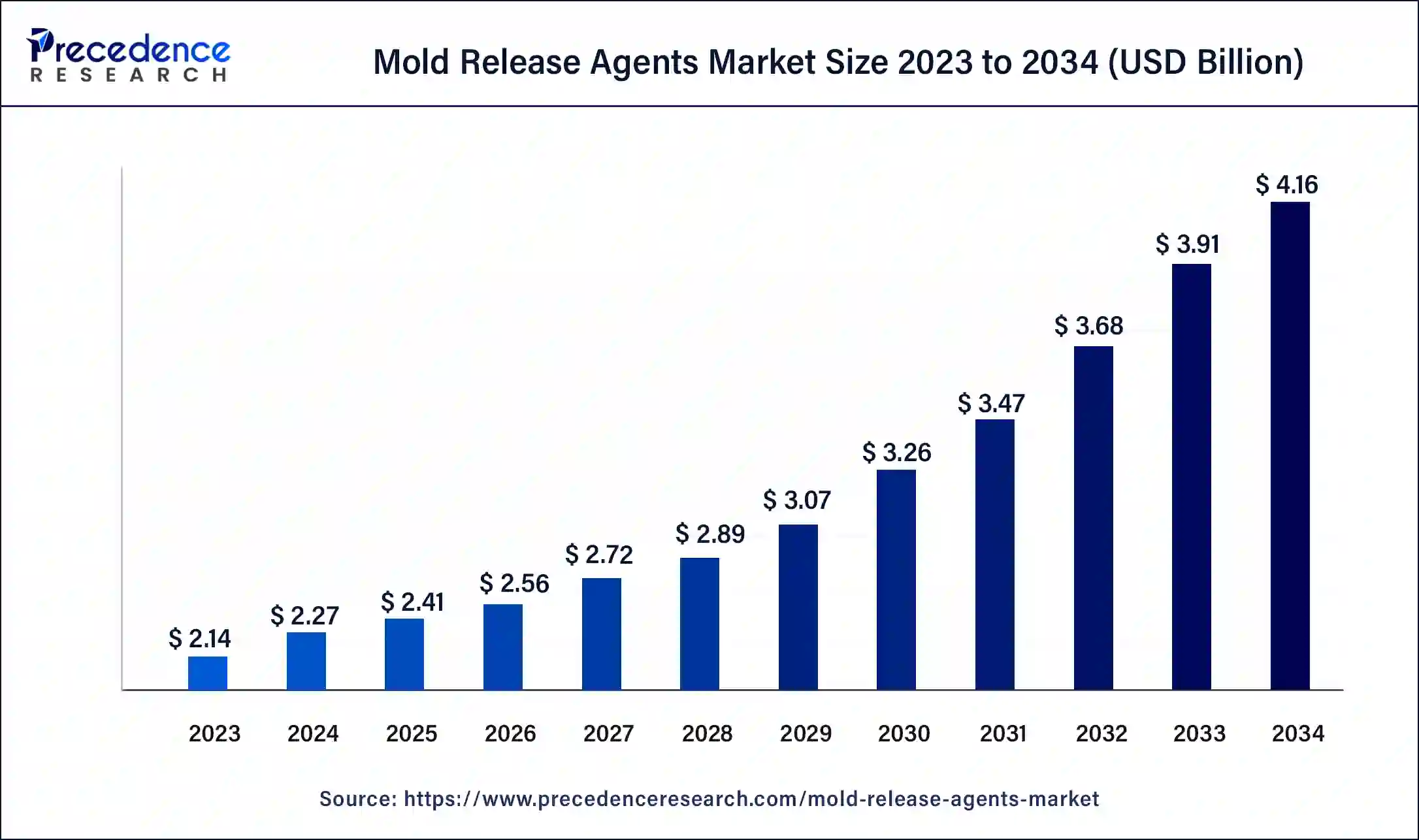
Mold Release Agents Market Key Takeaways
- Asia Pacific led the mold release agents market with the largest market share of share of 48% in 2024.
- North America is anticipated to grow notably in the market during the forecast period.
- By type, the water-based segment accounted for the biggest market share of 54% of the market in 2024.
- By type, the solvent-based segment is expected to witness significant growth in the market during the forecast period.
- By application, the composite molding segment has generated the biggest market share of 33% in 2024.
- By application, the die-casting segment is expected to grow significantly in the market during the forecast period.
What are Mold Release Agents?
A mold release agent is a chemical widely used to prevent molded parts from sticking to the surfaces of molds. It acts as a chemical barrier as the means of separation between the material being molded and the mold surface. Mold release agents find various applications in manufacturing industries and play an integral role, particularly those involving plastic, rubber, and other composite casting processes. The purpose is to ensure that the molded part can be easily removed from the mold without sticking to it, provide a seamless demolding process, and reduce the damaging risk of the finished product. The right mold release agent can save you money while reducing your overall production time.
Top 10 Countries in the Infrastructure Sector in the Calendar Year 2022
| China (Mainland) | 22.40% |
| United States | 18.20% |
| Taiwan, China | 4.70% |
| India | 4.60% |
| Japan | 4.10% |
| Germany | 4.00% |
| United Kingdom | 3.20% |
| Canada | 2.80% |
| France | 2.50% |
| Indonesia | 2.30% |
What are Mold Release Agents?
- The growing focus on sustainable and green manufacturing processes creates significant market opportunities to develop bio-based and environmentally friendly release agents and is expected to boost the mold release agents market expansion during the forecast period.
- The rising emphasis on sustainable and green manufacturing processes opens avenues for developing and adopting bio-based and environmentally friendly products in the mold release agents market.
- The rapid rise in the demand from the various many industries such as aerospace, automotive, construction, consumer products and food processing is expected to promote the mold release agents market growth in the upcoming years.
- The rapid industrialization and urbanization are anticipated to contribute significantly to the global mold release agents market's revenue.
- The rising investment by prominent market players in research and development to increase effectiveness and performance is likely to spur the market demand for the product in the coming years.
- The rising use of mold release agents in a wide variety of applications, including die-casting, PU molding, rubber molding, composite molding, plastic molding, and concrete, is anticipated to accelerate the mold release agents market growth during the forecast period.
Mold Release Agents Market Outlook:
- Industry Growth Overview: From 2025 to 2030, the market for mold-release agents will be increasing consistently, due in part to growing demand from the automotive, construction, rubber, and plastics sectors. This increase will be supported by the move toward low-waste, high-performance molding processes, especially in the Asia-Pacific region and North America.
- Sustainability Trends: Eco-friendly release agents are expected to experience increased prominence as industries move toward the usage of low-VOC, water-based, and solvent-free products. Some manufacturers are increasing their R&D spending to replace petroleum-based formulations with biodegradable plant-based materials in order to conform to some of the world's strictest emission limitations.
- Global Expansion: Key players are expanding their footprints in Southeast Asia, Eastern Europe, and LATAM to stay close to OEMs and take advantage of relaxed regulations. Many companies are also increasing their production and technical service centers to support the rapidly expanding molding industries in these areas.
- Major Investors: Due to strong profitability and niche product needs, private equity and corporate investors are entering the space. Firms with portfolios in advanced materials and manufacturing chemicals are financially backing companies pursuing high-performance release formulations.
Market Scope
| Report Coverage | Details |
| Market Size by 2034 | USD 4.16 Billion |
| Market Size in 2025 | USD 2.41 Billion |
| Market Size in 2026 | USD 2.56 Billion |
| Market Growth Rate from 2025 to 2034 | CAGR of 6.22% |
| Largest Market | Asia Pacific |
| Base Year | 2024 |
| Forecast Period | 2025 to 2034 |
| Segments Covered | Type, Application, and Regions |
| Regions Covered | North America, Europe, Asia-Pacific, Latin America, and the Middle East & Africa |
Market Dynamics
Drivers
Rising demand from the automotive and construction industries
The increasing demand from the automotive and construction industries is expected to contribute to the growth of the mold release agents market. The demand for mold release agents is increasing in the automotive and construction industries owing to their ability to minimize costs and improve efficiency, making them an attractive option to increase their productivity. Mold release agents are extensively used in the construction industry for the production of concrete and other building materials. They help prevent sticking and ensure smooth surfaces.
The surge in the development of infrastructure, especially in developing nations, increases product demand significantly. Molds are mostly commonly used to shape rubber parts and accessories, including those found in various automotive applications. The use of mold-release products can improve production times and assist in preventing faults in molded products. Thus boosting the mold release agents market growth during the forecast period.
- According to the IBEF report, FDI in construction development (townships, housing, built-up infrastructure, and construction development projects) and construction (infrastructure) activity sectors stood at USD 26.54 billion and USD 33.52 billion, respectively, between April 2000-December 2023.
- According to the data published by the Society of Indian Automobile Manufacturers (SIAM), the Auto industry produced a total of 2,59,31,867 vehicles, including passenger vehicles, commercial vehicles, three-wheelers, two-wheelers, and quadricycles from April 2022 to March 2023, compared to the previous year 2,30,40,066 units in April 2021 to March 2022. Total passenger vehicle sales increased from 30,69,523 to 38,90,114 units. Sales of passenger cars also increased from 14,67,039 to 17,47,376 compared to the previous year. The overall commercial vehicle sales increased from 7,16,566 to 9,62,468 units.
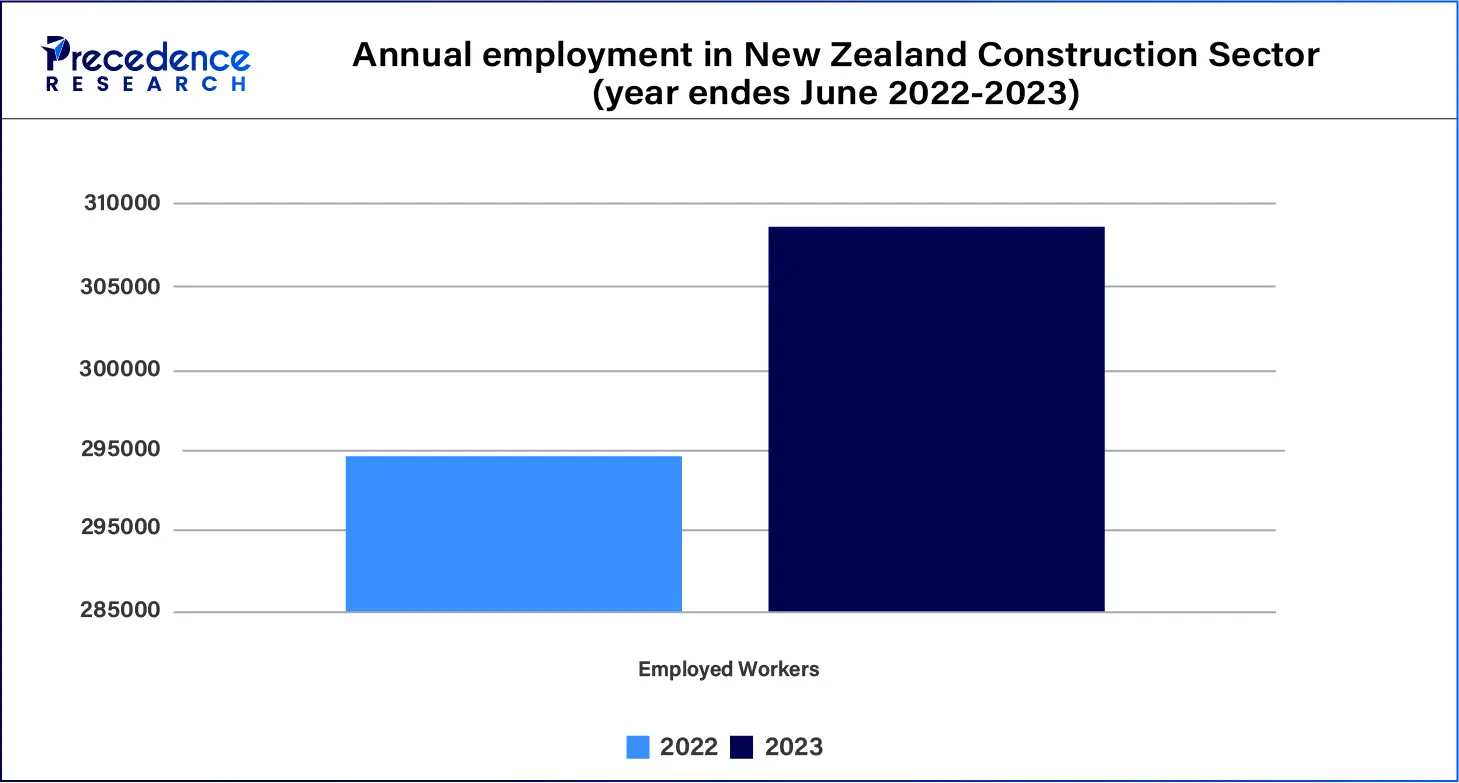
Restraint
Growing concerns over the environmental impact
The growing concerns over the environmental impact are anticipated to hinder the global mold release agents market. The increasing concerns over the environmental impact and severe health hazards related to harmful chemicals led to strict regulatory constraints and an increase in the need for compliance. The product uses fluorocarbons as one type, which poses a threat to the environment.
The stringent regulations of the Government related to chemical usage increase the pressure to shift towards biodegradable and eco-friendly mold release agents, which results in high costs associated with research and development proficiencies to develop effective alternatives that offer sustainable environmental benefits. In addition, the high costs associated with developing and commercializing eco-friendly mold release agents pose a challenge for small and medium-sized manufacturers. Such factors are likely to restrict the expansion of the mold release agents market in the coming years.
Opportunity
Rising technological innovation
The significant rise in technological innovation is projected to offer immense growth opportunities for the mold release agents market during the forecast period. The rising integration of nanotechnology and biodegradable additives in mold release formulations provides improved surface finish quality and minimizes environmental impact. The rapid innovations enhance the production of more efficient, affordable, and versatile release agents that can tap into various application sectors. Therefore, the rapid expansion of end-user industries represents lucrative opportunities for the mold release agents market in the coming years.
Type Insights
The water-based segment accounted for the dominating share of the mold release agents market in 2024. Water-based release agents are increasingly being used as they offer several benefits such as being non-polluting, safer, less expensive, smooth casting surface, green environment protection, good release effect, causing no damage to the surface of the casting, and others. Water release agents are different from traditional solvent-based release agents such as mineral oil. Water-based agents are environmentally friendly due to the absence of volatile organic compounds (VOCs).
Water-based agents are widely used in medium- and high-temperature applications. It provides a combination of effective release performance and safeguards molds from rust over time. Water-based release agents are more efficient than oil-based release agents. Water-based release agents are less costly than powder-release agents. Water-based release agents can also be categorized as wax, silicone, or fatty acid, depending on the effective release substance in the release agent. Such supportive factors are driving the growth of the market during the forecast period.
- In May 2024, Kao Corporation announced the launch of LUNAFLOW RA, a water-based mold release agent that maintains a slippery surface. It is a mold release agent for use in smoothly removing rubber and resin products from molds during manufacture. The product can be expected to improve work efficiency in the manufacturing process and is both solvent- and fluorine-free, making it friendly to both the workers and the environment.
The solvent-based segment is expected to witness significant growth in the mold release agents market during the forecast period. Solvent-based agents provide much faster drying time, making them suitable for high-volume manufacturing. These agents work by offering active silicone or wax ingredients onto mold surfaces. Solvents most commonly include xylene, acetone, mineral oil, and toluene. Solvent-based agents can be sprayed onto cloths for fast application by wiping and also on complex or large molds. However, It includes adverse effects on the environment and human health. It is supposed to be used with safety as it has flammable and combustible properties.
Application Insights
The composite molding segment held the largest share of the mold release agents market in 2024 and is expected to sustain its position throughout the forecast period. Composite manufacturing plays a crucial part in most modern manufacturing methods. Composite molding holds significance for automakers and small-part manufacturing. In composite molding, the product market is important for detaching the finished product from the mold. These agents act as non-stick agents that prevent the composite material from bonding or sticking to the mold and assist in ensuring a seamless demolding process.
The significant benefits offered by composite moldings, such as high strength-to-weight ratios, are essential for fuel efficiency and performance in various sectors, including aerospace and automotive. They provide excellent corrosion resistance, which makes them suitable for several marine applications. Their versatility also facilitates complex shapes and designs in engineering and architecture. These factors are anticipated to propel the expansion of the segment during the forecast period.
The die-casting segment is expected to grow significantly in the mold release agents market during the forecast period. The mold release agent plays an integral role in die casting to ensure the seamless separation of the casting from the mold. This agent assists in preventing the molten metal from sticking to the walls of the mold.
Die-release agents are most extensively used in industries such as aerospace, automotive manufacturing, consumer goods production, and others. Metal die-casting release agents are commonly utilized in several molding operations for magnesium, aluminum, zinc, and other metal materials. Thus bolstering the segment's growth in the coming years.
Regional Insights
Asia Pacific Mold Release Agents Market Size and Growth 2025 to 2034
The Asia Pacific mold release agents market size is exhibited at USD 1.16 billion in 2025 and is projected to be worth around USD 2.02 billion by 2034, poised to grow at a CAGR of 6.31% from 2025 to 2034.
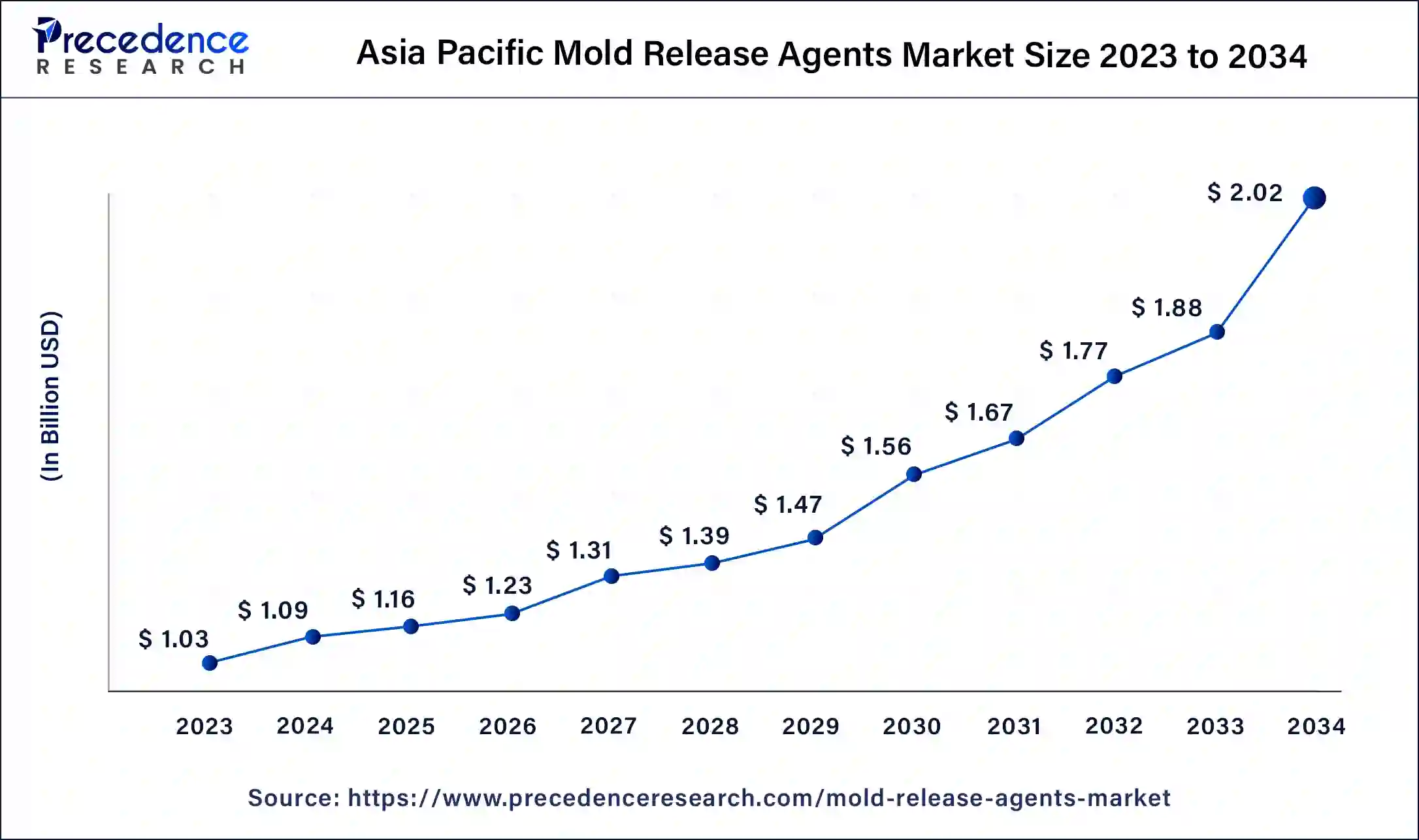
Asia Pacific held the dominant share of the mold release agents market in 2024. The region is observed to witness notable growth during the forecast period. The region is observed to witness prolific growth during the forecast period. The growth of the region is mainly attributed to surging industrialization, rising research and development activities, robust economic growth in the developing nations, easy availability of raw materials, stringent emission regulations, and growing demand for consumer electronics. The rising vehicle production, coupled with the increasing adoption of the die-casting technique for manufacturing metal body parts of numerous vehicles, acts as one of the major driving factors for this regional growth.
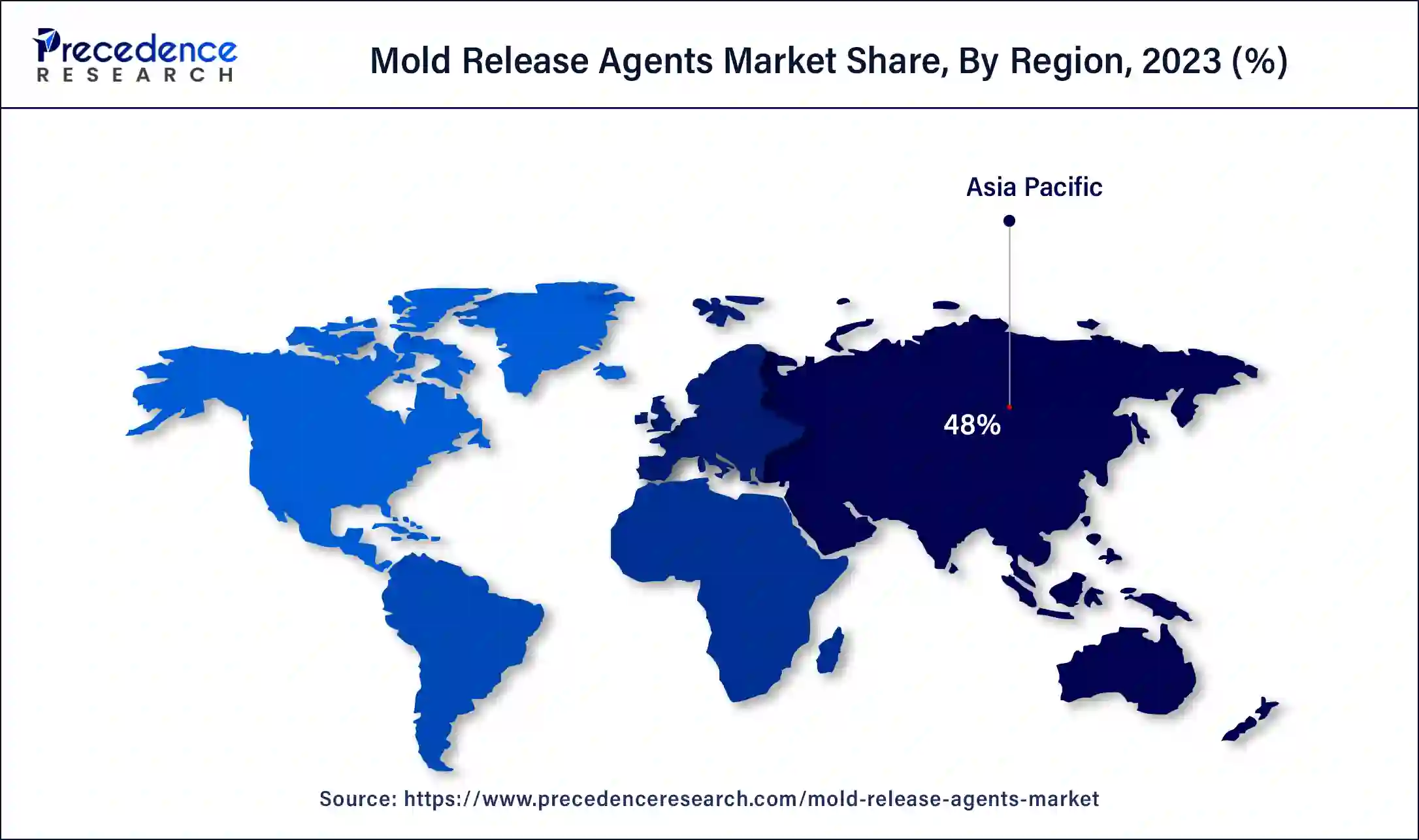
The fastest-developing economies in the region, such as China, India, Japan, and South Korea, are the major contributors to the mold release agents market. The rising demand from end-user industries, such as manufacturing, automotive, construction, and others, boosts the growth of the market. The steady growth in these sectors offers immense growth opportunities to the market due to the rising foreign investment, rapid industrialization, and industrialization. Furthermore, the increasing number of manufacturing plants and exponential rise in exports contribute to the growth of mold-release agents in the region.
- In August 2024, the Indian Cabinet approved the Pradhan Mantri Awas Yojana-Urban 2.0 Scheme, under which financial assistance will be provided to 1 crore houses to be constructed for urban poor and middle-class families. The investment of ? 10 lakh crore and Government subsidy of 2.30 lakh crore will be provided under the Scheme (PMAY-U 2.0).
- According to Invest India, an estimated 600 million people are likely to be living in urban centers by 2030, creating a demand for 25 million additional mid-end and affordable units.
- The Chinese construction sector will grow by 4%. China is one of the world's largest construction markets.
- The Chinese government announced its 2024 Budget in March 2024. The budget includes an expenditure of CNY28.6tn ($4tn) in 2024, which is an increase of 3.8% compared with the 2023 Budget. Additionally, in March, the government announced it plans to invest CNY1.2tn ($173bn) in transport infrastructure projects by the end of this year.
- In March 2024, the Yangtze River Delta region government announced an investment of CNY140bn ($19.6bn) to develop 32 railway infrastructure projects in the region in 2024.
- In February 2024, the Shanghai government announced it plans to start work on 24 projects with a combined investment of CNY42.1bn ($5.8bn) in 2024.
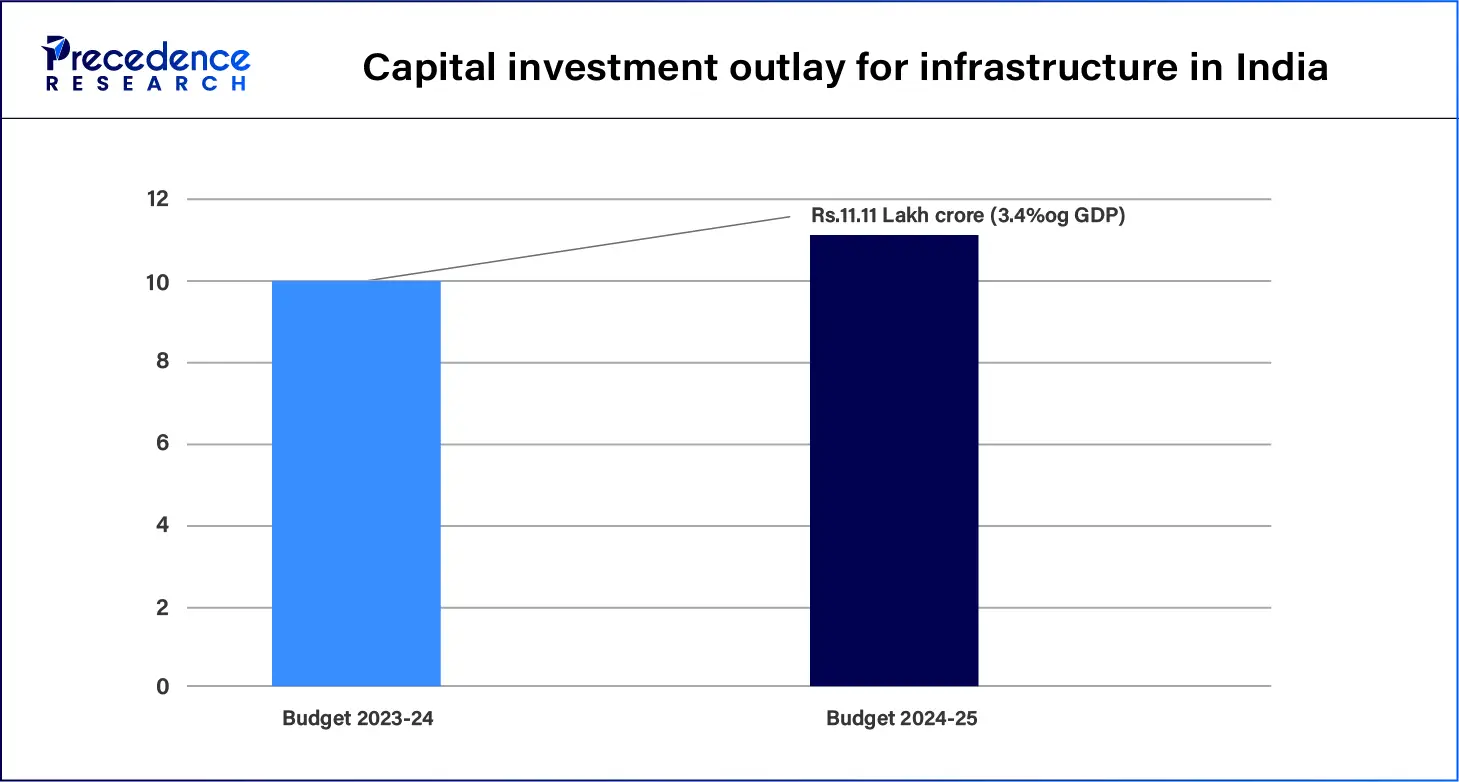
North America is anticipated to grow notably in the mold release agents market during the forecast period. The region's growth is driven by the presence of sophisticated industrial infrastructure, a significant rise in manufacturing activities, expansion of the construction sector, and strict execution of regulations by government entities to reduce volatile organic compound (VOC) emissions. Moreover, the rising demand for intricate and complex mold designs increases the demand for mold release agents to facilitate the demolding of complex parts.
Countries such as the United States and Canada represent a significant share of the mold release agents market, owing to the rising demand for a variety of items such as electronics, consumer goods, automotive components, and aerospace and defense parts, propelling the regional market's growth. Additionally, the increasing presence of market players in the region appears to be highly fragmented and competitive. Such factors are bolstering the growth of the region's market during the forecast period.
Why the Europea is Emerging as a Key Market for Mold Release Agents?
The European mold release agents market is expected to witness significant growth over the forecast period. Countries such as Germany, France, Italy, Spain, Russia, and the Netherlands are among the countries that are critical in developing the region's need for high-performance mold release solutions. These agents are necessary in the manufacturing of composite materials, plastics, rubber, as well as die-casting, which are common uses in the industrial foundation of Europe. Further, the tight regulation of Europe, as well as the trend towards sustainable and non-toxic compounds of chemical formulations, is causing pressure on manufacturers to introduce ecologically friendly mold release agents.
The mold release agents market is picking up in the United Kingdom, attributed to the growing levels of manufacturing activities and increasing interest in advanced engineering applications. The UK auto industry, which is characterized by innovation in electric cars and high-performance parts, is very dependent on the products of the mold release agents, which help to promote the efficiency of production and the quality of new products.
Why did Latin America Experience Considerable Growth in the Mold Release Agents Market?
Latin America was set to experience considerable growth driven by booming automotive, construction, and rubber industries. Countries invested heavily in local manufacturing and advanced molding technologies. There was an increasing demand in the region for affordable and water-based mold release agents. New opportunities were presented through growth in infrastructure, household products, and packaging.
Brazil Mold Release Agents Market Trends
Brazil was the leader of the Latin American market, as it possessed the largest industrial base and experienced strong demand from several sectors, including automotive, construction, and agricultural equipment. Manufacturers were converting to better molding technologies, opening extra demand for reliable release agents. Furthermore, growth was supported by the increase in production of plastics, footwear, and rubber.
Why did the Middle East & Africa Region grow rapidly in the Mold Release Agents Market?
Due to anticipated growth in construction, automotive assembly, and industrial manufacturing activities, the Middle East & Africa region is expected to grow steadily. Enhanced investment in infrastructure and localized production fueled demand for mold release agents. Countries were expending resources to modernize factories and improve molding processes. Along with mold release agents, demand also increased for building materials, plastics, and rubber goods. There was also a heightened interest in cleaner and water-based release agents, as industries sought to improve quality while reducing their carbon footprint on the environment.
The UAE Mold Release Agents Market Trends
The United Arab Emirates (UAE) drove the overall regional market with expanded construction projects and investments in commercial, industrial, and infrastructural projects. Manufacturers continued to implement and use mold release agents in cement products, plastics, rubber, and building components. The introduction of more advanced production facilities and the interest in higher quality materials remained strong indicators for future demand. Moreover, the UAE government also raised awareness regarding clean and modern manufacturing, which led to an increase in water-based mold release agents.
Mold Release Agents Market Companies
- Chem-Trend
- ASK Chemicals
- Axel Plastics Research Laboratories
- BÜFA
- DAIKIN INDUSTRIES, Ltd.
- Dow Corning
- Wacker Chemie
- Aerol Formulations
- Chem-Verse Consultants
- CHUKYO YUSHI
- Croda International Plc
- Michelman Inc.
- Cresset Chemical Company
- MCGee Industries, Inc.
- Marbocat Ltd.
- Grignard Company, LLC
- Quaker Chemical Corporation
- Moresco Corporation
- Henkel AG & Co. KgaA
- Croda International PLC
- LANXESS
- Daikin Industries, Ltd.
Top companies in the Mold Release Agents Market
- Daikin Industries, Ltd.: Daikin Industries, Ltd. provides a wide range of products, including mold release agent, air-conditioning systems, room heating, heat pump hot water supply systems, room air conditioning systems, packaged air-conditioning systems, and air conditioning systems for plants, facilities, and office buildings. The company's chemical products include fluoroplastics, fluorocarbons, fluorinated oils, mold release agents, water and oil-repellent products, dry air suppliers, and semiconductor etching products.
- LANXESS AG: LANXESS AG is a German specialty chemicals company, arising from the spin-off of the chemicals division and parts of the polymers business of Bayer AG. The company has operations in 32 countries. The company is organized into three business segments: Advanced Industrial Intermediates, Specialty Additives, and Consumer Protection.
- Henkel AG & Co. KGaA: Henkel AG & Co. KGaA is a multinational company and it operates in various business sectors, including mold release agents, adhesives, sealants, surface treatments, and other industrial chemicals. The company owns many well-known brands, including Loctite, Bonderite, Teroson, Technomelt, Aquence, and Schwarzkopf. The company has a broad and diverse business, offering bonds, adhesives, sealants, hair care products, laundry detergents, and fabric softeners.
Recent Developments
- In July 2024, New non-stick coating will improve shaping processes in injection molding and die-casting. UltraPLAS enables the perfect reproduction of mirror-finish surfaces. A new UltraPLAS coating developed by Fraunhofer researchers has proven to be an innovative solution to the challenges of primary forming processes. This advanced release and easy-to-clean coating is applied as a gradient layer using a cold plasma process and is suitable for materials such as tool steel, stainless steel, and aluminum.
- In November 2022, CHRYSO unveiled CHRYSO Dem Aqua 800, its new unlabelled vegetable oil emulsion mold release agent that meets the four primary performance criteria for mold release oils: surface finish quality, mold protection, HSE profile, and optimized consumption.
- In August 2024, Avient unveils a new non-PFAS mold release additive for high-temperature polymers. Formulated without intentionally added per- and polyfluoroalkyl substances (PFAS), this new non-PFAS additive can be used to enhance the manufacturing processes of high-pressure injection molding.
Segments Covered in the Report
By Type
- Water-based
- Solvent-based
- Other types
By Application
- Die Casting
- PU Molding
- Rubber Molding
- Composite Molding
- Plastic Molding
- Wood Composite & Panel Pressing
- Concrete
- Others
By Geography
- North America
- Asia Pacific
- Europe
- Latin America
- Middle East & Africa
For inquiries regarding discounts, bulk purchases, or customization requests, please contact us at sales@precedenceresearch.com
Frequently Asked Questions
Ask For Sample
No cookie-cutter, only authentic analysis – take the 1st step to become a Precedence Research client